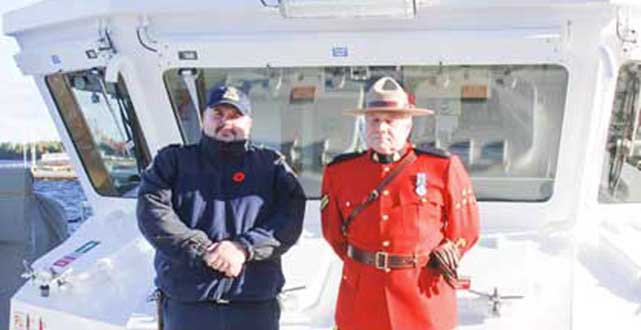NORTH CHANNEL—Early in November, the Port of Little Current had a visitor in the form of one of the Canadian Coast Guard’s brand new (not even christened yet) mid-shore patrol vessels, the Constable Carriere—a 43 metre long, seven metre beam ‘hero class’ maritime security ship.
Constable J.L. Francois Carriere was a member of the Royal Canadian Mounted Police (RCMP) based in Cape Breton, Nova Scotia. Constable Carriere died on November 30, 1997 while conducting an underwater search of a vessel believed to be smuggling illegal drugs. He is listed on the RCMP Roll of Honour.
Islanders can get used to the big red and white ship’s presence too, as it will be a regular feature on the North Channel during the shipping season, patrolling the waters between Sault Ste. Marie and Thunder Bay in Lake Superior and Midland in Lake Huron.
The large block lettering on the vessel’s midship denote her partnership with police, namely the RCMP, although officers with the OPP are also often aboard. Corporal Tim Waters of the RCMP explained that the vessel’s role, from a police standpoint, is national security and anything that comes up on the water, from routine checks for lifejackets and drinking and boating, as local police would do, to searching for smugglers of illegal drugs or weapons, as well as customs.
“No matter the size, we will stop any vessel and check for safety equipment,” the corporal said.
The Coast Guard, Chief Navigational Officer Tim Hopkins explained, provides the platform on which to operate. Coast Guard staff operates and maintains the vessel, allowing the RCMP to do their job. In case of emergency, the vessel will also be deployed to assist boaters in trouble, he added.
While the Constable Carriere itself was not found in Little Current this past summer (it was fresh off the shipbuilder’s yards in Halifax this fall), its staff was parked for five weeks on one of the Little Current finger docks with one of the ‘ribs’ (inflatables). Corporal Waters said that he and his fellow officers were able to familiarize themselves with the area and were looking forward to exploring more of the North Channel’s waterways.
“The success is that it was a good summer,” he said.
The Constable Carriere has a nine-person Coast Guard crew with capacity for five law enforcement officers.
Little Current is the only port on the North Channel right now that can accommodate the vessel, but the ship doesn’t necessarily need a mooring wall as the quick-moving inflatables make it possible for the crew to anchor outside of a community and boat in.
“We are around, and we want people to know we are around,” Corporal Waters said.
Some of the crew made themselves known during the Remembrance Day services in Little Current, with the Coast Guard and RCMP—dressed in their trademark red serge—attending the ceremonies at Little Current Public School and the Legion, as well as the Manitoulin Centennial Manor, much to the delight of everyone. The Constable Carriere also welcomed a tour of the Manitoulin Sea Cadet Corps, who got special treatment from all the staff, asking plenty of questions of the crew pertaining to everything from navigation to bow thrusters and life aboard.
The Constable Carriere is one of six mid-shore patrol vessels that have been made operational since July 2012. According to the Coast Guard’s website, “Mid-Shore Patrol Vessels will become the primary platform for the joint Canadian Coast Guard and the Royal Canadian Mounted Police’s Marine Security Enforcement Team in the Great Lakes and the St. Lawrence Seaway. The primary mission of this program is to: Enhance national security; respond to potential threats, and safeguard and address federal issues on water enforcement requirements.”
The vessels will be used to support the Department of Fisheries and Oceans Compliance and Enforcement program on the Atlantic and Pacific Coasts. As part of this program, Canadian Coast Guard personnel and the Department of Fisheries and Oceans’ Fishery Officers work together to: Conduct surveillance of fisheries operations in order to ensure all regulations and guidelines are being respected; to seize, recover, store and transport illegal fishing gear; to monitor and patrol the oceans (coastlines and international boundaries) and to provide a Canadian presence; and discourage smuggling and fish poaching.





